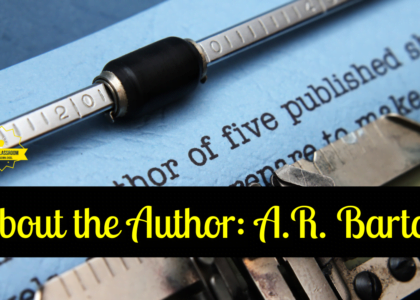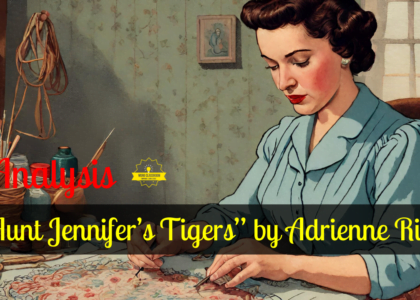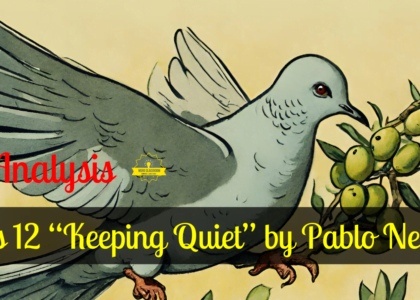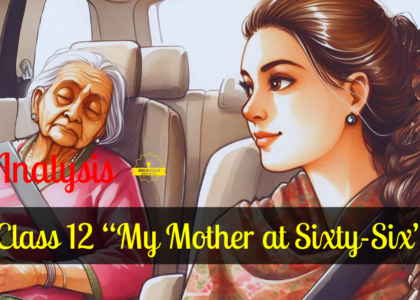NOTE-Not included in the CBSE Syllabus for 2024-2025

Stephen Spender
Stephen Spender (1909-1995) was a British poet, essayist, and translator. A prominent figure of the 1930s literary circle, he co-founded “New Verse” magazine and was associated with the Auden Group. Throughout his life, Spender remained politically engaged, supporting various causes and writing extensively on cultural and political issues.
Table of Contents
Also Read: Aunt Jennifer’s Tigers, My Mother at Sixty-Six, A Thing of Beauty by John Keats, A Roadside Stand
Explanation ‘An Elementary School Classroom In A Slum‘:
‘An Elementary School Classroom in a Slum’ is a powerful and poignant poem by Stephen Spender. The poem explores the stark reality of an impoverished school setting and raises concerns about the impact of poverty and neglect on the education and future of young children.
It vividly depicts children’s dismal conditions in a poverty-stricken urban slum, contrasting their harsh reality with the possibilities of a brighter future. The poem explores inequality, limited opportunities, and the power of education to transform lives.
The poem begins by setting the scene where the children’s faces are compared to “rootless weeds,” suggesting their lack of stability and belonging. The imagery of “hair torn round their pallor” highlights their unkempt appearance and unhealthy living conditions. Spender introduces individual children in the classroom, each representing their struggles.
The “tall girl with her weighed-down head“ reflects her burden and weariness, possibly due to familial responsibilities or a difficult life. The “paper-seeming boy, with rat’s eyes” evokes the idea of vulnerability and lack of confidence, perhaps influenced by the harsh environment around him. The “stunted, unlucky heir / Of twisted bones“ suggests a child born into unfortunate circumstances, trapped in a cycle of poverty and illness. The reference to a “father’s gnarled disease” implies a hereditary burden.
Among these students is one “unnoted, sweet and young“ boy whose eyes “live in a dream.” He escapes the harsh reality of the slum by daydreaming about a world like a “squirrel’s game,” free and joyful, existing in a tree-filled room.
The poem then shifts to describe the classroom’s walls adorned with “donations,” featuring images of Shakespeare’s head and various picturesque landscapes. These symbolise the stark contrast between the children’s current reality and the possibilities of a more cultured, educated, and prosperous world. However, the poet remarks that the children’s world is not represented on these walls or the maps that adorn them.
Spender criticises the educational system, stating that the maps and lessons do not address the children’s immediate needs or provide them with the tools to escape their bleak environment. He questions whether exposing them to literature and a distant, seemingly unattainable world like Shakespeare’s is futile, given their desperate circumstances.
The poet’s call to action is directed at the “governor, inspector, visitor“, and anyone in a position of influence. He urges them to break the barriers that confine the children’s lives, like the catacombs, and expose them to a better reality. He envisions a world where the children can explore green fields and open their minds to knowledge represented by books with “white and green leaves open.” Spender emphasises the importance of education to empower these children to reshape their future and rise above their present circumstances.
‘An Elementary School Classroom in a Slum’ is a thought-provoking poem that highlights impoverished children’s social injustices and emphasises the transformative potential of education to offer hope and a path to a better life. It is a powerful reminder of society’s responsibility to address inequality and provide opportunities for all children to thrive.
Analysis of An Elementary School Classroom In A Slum:
‘An Elementary School Classroom in a Slum’ by Stephen Spender is a morose and thought-provoking poem that paints an uncomfortable picture of the harsh realities faced by children living in poverty and deprivation. Through powerful imagery and contrasting elements, Spender addresses the societal neglect and injustice experienced by these underprivileged children.
The opening lines set the tone, describing the children’s faces as “far from gusty waves“ and resembling “rootless weeds.” This simile immediately establishes a sense of detachment, highlighting the children’s alienation from the natural world and lack of a nurturing environment. Their physical appearance is marked by destitution, with torn hair and pallor, emphasising their impoverished condition.
Spender introduces individual children in the classroom, each representing a different aspect of the disadvantaged. The “tall girl” seems burdened and defeated, the “paper-seeming boy” appears vulnerable and watchful like a rat, and the “stunted, unlucky heir” carries the weight of a hereditary disease passed down from his father. These portrayals showcase the children’s struggles and reflect the adverse circumstances they inherit.
The mention of “Shakespeare’s head“ and a “civilized dome riding all cities“ represents the outside world of knowledge and culture that contrasts sharply with the bleak surroundings of the slum. The juxtaposition of these images with the poverty-stricken reality of the children’s lives highlights the stark disparities in society. The map symbolises a world of possibilities, but for these children, it remains distant and unattainable, confined to the walls of their classroom.
The poem questions the societal norms and values that have failed these children. The reference to Shakespeare as “wicked” implies that the literary and cultural heritage celebrated by society does little to alleviate the suffering of the underprivileged. Instead, it tempts the children with dreams of a different life they cannot access due to their circumstances.
The phrase “fog to endless night” portrays their lives’ lack of hope and opportunity. The image of “skins peeped through by bones” emphasises their physical frailty and vulnerability. At the same time, the “spectacles of steel with mended glass” suggests how their limited vision and outlook are patched together with difficulty.
In the concluding lines, the poet calls upon those in positions of authority and power, such as the “governor, inspector, visitor,” to take action and break the cycle of neglect. The map, representing education and a better future, must become a window to the world beyond the slum. The poem advocates for a transformative education that empowers these children to escape the confines of their poverty and engage with the broader world.
The hope lies in giving these children access to knowledge, represented by “green fields” and “books with white and green leaves open.” By doing so, they can claim their place in history and create a brighter future. The poem ultimately advocates for social change and equality, challenging readers to confront the harsh realities of poverty and take steps to break the cycle of deprivation.
Tone:
The tone of ‘An Elementary School Classroom in a Slum’ is critical, impassioned, and compassionate. A deep concern for the plight of the underprivileged children in the slum marks Stephen Spender’s style. He criticises the stark contrast between their impoverished reality and the idealised world on the classroom walls. The poet’s language and imagery convey a strong emotional response, urging readers to take action and address the inequality and injustice these children face.
Themes ‘An Elementary School Classroom in a Slum‘:
- Poverty and Inequality:
The poem’s central theme is the harsh reality of poverty and inequality faced by the children in the slum. Spender highlights the contrast between these children’s limited opportunities, grim living conditions, and the privileged world on the classroom walls.
- Education and Opportunity:
The poem reflects on the role of education and its potential to uplift disadvantaged children. Spender points out the irony of offering a world of knowledge and culture through classroom decorations while the children’s world remains constrained and deprived.
- Power and Responsibility:
The poem addresses those in positions of authority, such as the “governor, inspector, visitor,” who have the power and responsibility to make a positive change in the lives of these children. Spender calls for action to break down the barriers that confine the children to their slums and provide them opportunities for growth and a brighter future.
Structure:
The poem consists of four octets (an eight-line stanza).
Symbolism ‘An Elementary School Classroom in a Slum‘:
- Shakespeare’s Head and Decorations:
The donated decorations, such as Shakespeare’s head and scenic landscapes, symbolise a broader world of knowledge, culture, and opportunity that is distant and inaccessible to the children in the slum. They represent the stark contrast between the idealised world of learning and the harsh reality of poverty and limited prospects.
- “Fog” and “Endless Night”:
The recurring imagery of “fog” and “endless night” symbolises the children’s confined and uncertain lives in the slum. It conveys their need for clarity about the future and the limitations imposed upon them by their surroundings.
- Windows and Catacombs:
The closed windows symbolise the barriers that confine the children’s lives. They are shut like “catacombs,” indicating a sense of entrapment and isolation from the outside world. The poet calls for these windows to be opened, symbolising the need for access to opportunities and a broader view of the world.
- “Rootless Weeds” and “Twisted Bones”:
The description of the children as “rootless weeds” and the imagery of “twisted bones” represent the harsh impact of poverty on their physical and emotional well-being. These symbols evoke a sense of fragility, vulnerability, and malnourishment, depicting the challenging conditions the children endure.
- “Green Fields” and “Gold Sands”:
The final stanza’s mention of “green fields” and “gold sands” symbolises a world of hope, prosperity, and freedom. It represents the poet’s aspiration to see these children break free from their current circumstances and have access to a brighter, more promising future.
- “Paper-seeming boy, with rat’s eyes”:
This symbolises the child’s frailty and vulnerability, emphasising how poverty and neglect have affected his appearance and demeanour. The “rat’s eyes” evoke a sense of scavenging and survival instincts, implying the harshness of his environment.
- “History theirs whose language is the sun”:
This phrase symbolises the power of education and knowledge in transforming the lives of these children. Through education, they can reclaim their history and culture and step out of the shadow of poverty and ignorance.
To summarise, ‘An Elementary School Classroom in a Slum’ is a powerful critique of the societal neglect and inequality underprivileged children face. Through vivid imagery and contrasting elements, Stephen Spender highlights the harsh realities of poverty and advocates for transformative education and social change. The poem serves as a reminder of the moral responsibility to address the plight of the less fortunate and create a more equitable world.
Line-by-Line Explanation-‘An Elementary School Classroom In A Slum‘:
- “Far far from gusty waves these children’s faces.”
The poem begins with the image of children far removed from the joyful, carefree nature of the sea waves. Their faces are not vibrant and lively.
- “Like rootless weeds, the hair torn round their pallor:”
The children are compared to them, suggesting their lack of stability and rootedness. Their hair seems lifeless and torn, emphasising their unhealthy appearance.
- “The tall girl with her weighed-down head.”
The tall girl is burdened and appears downtrodden, likely due to her difficult circumstances.
- “The paper-seeming boy, with rat’s eyes.”
The boy is pale and thin, with eyes resembling a rat, possibly hinting at a sense of fear and vulnerability.
- “The stunted, unlucky heir of twisted bones, reciting a father’s gnarled disease,”
This line describes a child who inherited physical deformities from his father, and he is reciting a lesson about his father’s ailment.
- “His lesson, from his desk. At back of the dim class”
The child delivers his lesson from the back of the poorly lit classroom.
- “One unnoted, sweet and young. His eyes live in a dream”
An unnoticed child in the class appears innocent and dreamy, lost in his own thoughts.
- “Of squirrel’s game, in tree room, other than this.”
His dream takes him to a world of freedom and playfulness, imagining a space other than the dreary classroom.
- “On sour cream walls, donations.”
The walls are described as “sour cream” due to their faded and unappealing appearance. Donations are displayed on them, likely educational aids provided by well-meaning individuals or organisations.
- “Shakespeare’s head, Cloudless at dawn, civilized dome riding all cities.”
A picture of Shakespeare is prominently displayed, symbolising the presence of high culture and knowledge. It contrasts with the dire surroundings of the children.
- “Belled, flowery, Tyrolese valley. Open-handed map Awarding the world its world.”
The map depicts beautiful and prosperous places, such as the Tyrolese Valley, symbolising the world’s opportunities that seem unreachable to these children.
- “And yet, for these Children, these windows, not this map, their world,”
The children’s world is limited to what they see through the windows of their classroom, not the grand possibilities shown on the map.
- “Where all their future’s painted with a fog,”
The future seems uncertain and unclear to these children, like a fog obscuring their path.
- “A narrow street sealed in with a lead sky
Far far from rivers, capes, and stars of words.”
Their surroundings are dreary, with a narrow street and a “lead sky” devoid of hope or inspiration.
- “Surely, Shakespeare is wicked, the map a bad example.”
The speaker challenges the significance of high culture like Shakespeare and the promising map that only highlights the children’s lack of opportunities.
- “With ships and sun and love tempting them to steal —”
The children are tempted by the allure of a better life, symbolised by ships, the sun, and love, but they are forced to resort to stealing to survive.
- “For lives that slyly turn in their cramped holes From fog to endless night?”
Their lives are confined to cramped and gloomy spaces, where they transition from one hopeless situation to another.
- “On their slag heap, these children
Wear skins peeped through by bones and spectacles of steel”
The children are described as living on a slag heap, a metaphor for their impoverished and desolate living conditions. They appear malnourished and wear tattered clothes with steel-framed spectacles.
- “With mended glass, like bottle bits on stones.”
Their glasses are patched and repaired with mended glass, illustrating their lack of resources for proper eyewear.
- “All of their time and space are foggy slum.”
The children’s lives are engulfed by the fog of poverty and the grim environment of the slum.
- “So blot their maps with slums as big as doom.”
The speaker suggests that instead of showing promising places on maps, the maps should represent the reality of their lives in the slums, emphasising the urgency to address the issue.
- “Unless, governor, inspector, visitor,”
The poem now addresses those in positions of authority and influence.
- “This map becomes their window and these windows”
The map and the classroom windows can serve as gateways to a broader world.
- “That shut upon their lives like catacombs,”
The classroom windows, rather than providing hope and a view of a better future, are like tomb-like catacombs that confine the children’s potential.
- “Break O break open till they break the town”
The speaker urges those in power to break open the barriers that hold the children back, allowing them to break free and change their surroundings.
- “And show the children to green fields, and make their world”
Bring them to a world of green fields, symbolising a better and healthier environment.
- “Run azure on gold sands, and let their tongues Run naked into books the white and green leaves open”
The children should experience a vibrant world with blue skies and golden beaches, where they can freely explore knowledge by reading books.
- “History theirs whose language is the sun.”
In this better world, the children will have a rich history and heritage illuminated by the sun, symbolising enlightenment and hope.
Literary Devices ‘An Elementary School Classroom in a Slum‘:
Extra Questions ‘An Elementary School Classroom in a Slum‘:
Q1: What are the children’s living conditions in the poem?
A1: The children live in a slum with poor living conditions, suffering from malnutrition and neglect. They lack access to proper education and opportunities, trapped in a bleak and desolate environment.
Q2: What is the poet’s view of the world depicted on the map?
A2: The poet sees the world depicted on the map as distant and unattainable for the slum children. It represents a beautiful and cultured world but feels disconnected from its harsh reality.
Q3: What does the phrase “rootless weeds” symbolise?
A3: “Rootless weeds” symbolises the children’s lack of stability and nurturing. They need proper support, like weeds without a firm ground to grow in.
Q: Why does the poet call Shakespeare “wicked”?
A4: The poet calls Shakespeare “wicked” to criticise how literature and culture are presented as unattainable dreams for the slum children. They cannot appreciate or benefit from such knowledge due to their circumstances.
Q4: What does the phrase “foggy slum” signify?
A4: “Foggy slum” signifies the children’s suffocating and unclear environment, filled with poverty and limited opportunities. Their lives are obscured by a lack of clarity and hope for a better future.
Q4: What is the contrast between the children’s world and the world depicted on the map?
A4: The poem draws a sharp contrast between the world depicted on the map, full of beauty, culture, and opportunities (such as Shakespeare’s head, Tyrolese valleys), and the bleak world the children inhabit. The map presents a hopeful and vast world, while the children’s reality is confined to a foggy slum with limited prospects. The map represents the potential for a better life, yet the children are trapped in poverty and despair.
Q5: What does the poet suggest to solve the children’s plight?
A5: The poet implores the authorities (“governor, inspector, visitor”) to take action and change the children’s lives. They should break open the limitations imposed on the children and expose them to a world beyond their slum. The poet urges them to introduce education (“books with white and green leaves open”) and provide opportunities for the children to experience the beauty of nature (“green fields” and “gold sands”). By doing so, the children’s world can be transformed, and they can find hope and a brighter future.
Q6: What is the poet’s attitude towards the world depicted on the map and the world of the slum?
A6: The poet’s attitude towards the world depicted on the map is critical, suggesting that it seems almost mocking or irrelevant to the children living in the slum. The map represents a world full of possibilities, but it feels distant and disconnected from the reality of the children. The poet’s attitude towards the slum world is empathetic and concerned. The children’s suffering and limited opportunities are seen as a tragedy, and the poet calls for action to change their circumstances.
Q7: What does the poet mean by the line “His lesson, from his desk” in the poem?
A7: The line “His lesson, from his desk” refers to the boy with twisted bones reciting his father’s gnarled disease as a lesson. It suggests that the child is not learning conventional academic subjects like other children but is instead burdened with the knowledge of his family’s unfortunate hereditary condition. This highlights the harsh reality that some children are forced to face in the slums, where their circumstances and limited resources shape their education.
Q8: Why does the poet refer to Shakespeare as “wicked”?
A8: The poet’s reference to Shakespeare as “wicked” is meant to criticise how literature and high culture are often presented to the children in the slum. While Shakespeare’s works and the broader world of literature are celebrated for their richness and beauty, they remain distant and inaccessible to impoverished children. The poet suggests that such knowledge, without proper context or means of attainment, such knowledge can seem almost cruel or taunting to those who cannot benefit from it.
Q9: What does the phrase “Belled, flowery, Tyrolese Valley” signify in the poem?
A9: The phrase “Belled, flowery, Tyrolese Valley” represents an idyllic and picturesque image of a beautiful valley in Tyrol, Austria. It symbolises a serene and idealised landscape, a stark contrast to the grim reality of the slum where the children live. The image of this valley emphasises the stark disparity between the children’s impoverished environment and the world of natural beauty and abundance depicted on the map.
Q10: What is the significance of the phrase “All of their time and space are foggy slum”?
A10: The phrase “All of their time and space are foggy slum” highlights the suffocating nature of the children’s lives in the slum. It implies their entire existence is confined to a foggy and dim environment, with little clarity or hope for a better future. “foggy” suggests a lack of transparency and vision. At the same time, “slum” reinforces their disadvantaged living conditions, trapped in a cycle of poverty.
Q11: What message does the poet convey through the poem?
A11: The poem conveys a powerful message about the urgent need to address the plight of underprivileged children living in slums. The poem critiques the societal neglect and indifference towards these children’s education and well-being. It calls on the authorities and society to break the barriers that hold back these children and provide them with opportunities for a better life. The poem advocates for education, exposure to the beauty world’s beauty the empowerment of these children, emphasising the importance of creating a nurturing and supportive environment for them to thrive.





